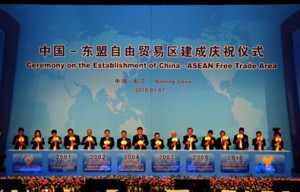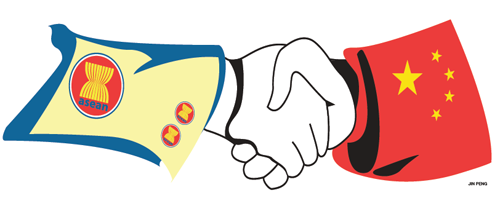 China – ASEAN Free Trade Area?abbr. CAFTA?, is a free trade zone established among China and 10 ASEAN countries. On January 1, 2010, the Free Trade Area officially initiated. Since its establishment, the trade between ASEAN and China accounted for 13% of world trade, becoming a huge economic power covering 11 countries, boasting 1.9 billion populations and a GDP of $ 6000 billion. At present the CAFTA is not only the world’s most populous free trade area, but also the largest one among developing countries.
China – ASEAN Free Trade Area?abbr. CAFTA?, is a free trade zone established among China and 10 ASEAN countries. On January 1, 2010, the Free Trade Area officially initiated. Since its establishment, the trade between ASEAN and China accounted for 13% of world trade, becoming a huge economic power covering 11 countries, boasting 1.9 billion populations and a GDP of $ 6000 billion. At present the CAFTA is not only the world’s most populous free trade area, but also the largest one among developing countries.
Since 2002 when China and ASEAN signed the basic documents of the Free Trade Area, the parties have gradually reduced or exempted tariffs. As a result, a unified market consists of 11 countries is gradually taking shape.
Early Harvest Program
“Early Harvest Program ” is an integral part in building the China – ASEAN Free Trade Area, the aim of which is to bring benefits to the consumers in this area in a timely manner. According to the “Early Harvest Program”, from January 1, 2004, the tariff will be reduced in more than 500 kinds of products. And in 2006, the tariff on these products will be totally exemplified.
These products are mainly agricultural products listed in the “Customs Tariff “from the Chapter I to Chapter VIII, with some listed in other chapters. And these products are: live animals, meat and edible meat offal, fish, dairy and other animal products, live trees, edible vegetables, fruits and nuts. In some countries, coconut oil, palm oil, vegetable oil, etc. are also included in the “Early Harvest Program”. In October 1, 2003, China and Thailand took the first step in initiating the program.
According to the time frame of the CAFTA Early Harvest Program, China and six ASEAN countries’ (Malaysia, Singapore, Indonesia, Philippines, Thailand, and Brunei) tariff reduction and exemption schedule is as follows: products whose MFN tariff rates are higher than 15% would be reduced to 10% by January 2004, 5% by January 2005, and 0% by January 2006. All products with MFN tariff rates between 5-15% would be reduced to 5% by January 2004, and 0% by January 2005, and products whose MFN tariff rates are lower than 5%would be exempted by January 2004.
In new ASEAN member countries (Vietnam, Laos, Myanmar, Cambodia), all products whose MFN tariff rates are above 30% (inclusive) would be reduced to 20% and a further 5% would be reduced with each passing year and by 2009 the rates would be totally exempted( 2010 for Cambodia). All products whose MFN tariff rates are between 15% (inclusive) and 30 %( not included) would be reduced to 10% in Vietnam by January 2004, 5% by January 2006 and 0% by 2008, as for other new ASEAN member countries, 10% by 2006 and 5% by 2008. When it comes to the products whose MFN tariff rates are below 15%, the rates would be reduced to 5% by January 2004 and 0% by January 2006, as for other new ASEAN member countries, 5% by 2006 and 0% by 2008.
Opening Schedule for Trade in Goods
On July 20, 2005, China – ASEAN free trade area tariff reduction process was officially initiated, which marks the “Trade in Goods Agreement ” has officially entered the implementation phase, also marks the construction of China – ASEAN free trade zone has officially initiated. The Trade in Goods Agreement provides that in addition to the early harvest products (mainly agricultural products ), and the rest of the products are classified into two categories?normal products and sensitive products.
Opening Schedule for Trade in Service
In January 2007, China and ASEAN signed a free trade zone Trade in Services Agreement, which was implemented from July 2007. Countries should list their specific opening commitments in the form of schedules of concessions. The specific commitments of countries are a higher level of liberalization commitments made on the basis of their respective WTO General Trade in Services Agreement Commitment.
The main content of China’s specific commitments: China’s commitment covers the construction, environmental protection, transportation, sports and business services (including computer, management consulting, market research, etc.), and 26 sub-sectors of the five service sectors. The commitment includes further opening part of service sectors, allowing the establishment of wholly-owned enterprises, relaxation of the foreign equity limit and the national treatment.
In accordance with the provisions of the progressive liberalization, the bidding above acting as the first batch of market access commitments schedule would be signed together with trade in services agreement. At present, the two parties are under negotiation for the second batch of market access. After negotiations, a Protocol would be signed to include the second batch of schedules of concessions into the Trade in Service Agreement. Meanwhile, in accordance with the deliberation provision, in the future the two parties could carry out negotiations on the further opening up in the service trade, so as to gradually bring the trade in service into a free state.







dear sir/ madam
i would like to work with you in Pakistan. please guide me regarding this, also please i would like to visit china for a visit the market please guide me how would i get visa for visit china please please help me.
Mahmood Ahmed Ch
0092-333-433-5756
===============
Dear Mahmood,
Please refer to this link on how to apply for Visa in China.
http://www.visaforchina.org/
Regards,
Steven
Chinaimportexport.org
Dear Sir/Madam,
I would like to check apparel produced in ASEAN countries (please provide the country name list)if export to China, is there any tax need to pay? Is there any VAT as well? Will there be any limit for the material c/o eg material import from China but produce in ASEAN or material and goods is from ASEAN (the difference of the tax rate etc). Thks.
Rgds,
Ann Chan
Dear Ann,
It is very important to know which country you are from.
For some countries like Thailand, Singapore, the tariff now is 0. But for some countries, there is still tariff.
Regards,
Steven
Chinaimportexport.org